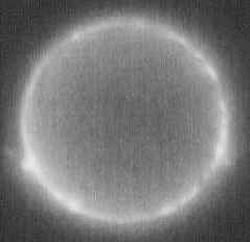Flexibility of Cell Membranes

Filmy bags of fluid that crawl, extend finger-like protrusions, and engulf smaller objects–living cells exploit engineering principles that physicists would love to understand. But at 10 to 100 µm in size, they’re tough to get a handle on. Now a team in France has demonstrated how to deduce the material properties of cell membranes from the thermal wobbling of an attached bead. In the February Physical Review E, they apply their approach to a vesicle, or membrane sphere, which they enmesh in the same protein filaments that reinforce biological membranes. They hope to apply their method to increasingly cell-like architectures.
To understand what makes cells simultaneously stiff and oozy–or viscoelastic–biophysicists have mostly relied on large-scale measurements. On the macroscopic scale, they’ve deformed gels made from protein filaments and have flexed naked films of lipids, the soap-like molecules that make up cell membranes. On a smaller scale, they’ve pressed and pulled on entire cells. But until now, they have not been able to probe the structure of an intact membrane on a scale that cells themselves would consider small–at least not without severely distorting the membrane.
Emmanuele Helfer and her colleagues at the University of Strasbourg presented their wobbling-bead methodology in PRL in July [1] and their latest paper elaborates on it. The researchers place a coating of sticky molecules on vesicles of about 20 µm diameter and on beads of 1 µm or larger. Using a homemade microscope, they manipulate the beads with a steeply focused laser beam known as optical tweezers and immobilize vesicles by rapidly switching the laser between beads stuck to opposite faces. From the jostling of one bead in the weak grip of the tweezers, they compute a power spectrum, a plot of the size of displacements vs. their frequency on a log scale. The team computes spectra for both in-plane bead motions and for motion perpendicular to the plane of the membrane.
The paper interprets the spectra with a theory that Fred MacKintosh of the University of Michigan, Ann Arbor, developed during a sabbatical in Strasbourg. The amplitude of the displacements of unattached beads diminishes with a constant slope of -2, as expected for Brownian motion in a viscous medium (sugar water). The slope is less steep for the out-of-plane wobbling of a bead stuck to a naked vesicle–indicating partial elasticity–but appears Brownian for within-plane motion–consistent with the membrane’s liquid crystal structure. For a bead attached to a protein-sheathed vesicle, the slopes for both types of motion are viscoelastic, and the theory accounts for the values of these slopes straightforwardly, assuming that the protein husk acts like actin filaments in a gel.
David Weitz of Harvard University says the properties of other membrane-filament architectures might turn out differently, though he suspects they will not. He cautions that several properties of the protein-lipid system in these vesicles make them unlike those of real cells. Also, says Weitz, cells often deform over seconds or hours, so he hopes future measurements will probe lower frequencies. Weitz characterizes the Strasbourg measurements as “a first step”–but he also calls them “cool stuff.”
“The simple model seems to do a remarkably good job of explaining the data,” says Tom Lubensky of the University of Pennsylvania, Philadelphia. “They’ve shown the technique can be used more generally.”
–Oliver Baker
Oliver Baker is a freelance science writer based in Davis, CA.
References
- E. Helfer et al., Phys. Rev. Lett. 85, 457 (2000)


